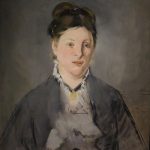When we delve into the world of art and its most intriguing figures, Jean-Michel Basquiat and Suzanne Mallouk often emerge as fascinating characters. Their relationship was passionate, volatile, and deeply influential to both their lives and Basquiat’s art. Understanding this relationship provides insight into the creative process and the tumultuous world of the 1980s New York art scene. Let’s explore their lives, the impact they had on each other, and how their relationship left a lasting mark on art history.
Early Life and Background
Jean-Michel Basquiat was born on December 22, 1960, in Brooklyn, New York. His mother, Matilde, was of Puerto Rican descent, and his father, Gérard Basquiat, was Haitian. Growing up, Basquiat showed a talent for drawing. He created his first works on sheets of paper his father brought home from work. However, he struggled with formal education and dropped out of high school, which led him to pursue art independently.
As a teenager, Basquiat began to immerse himself in the vibrant New York City art scene. He gained notoriety under the graffiti tag “SAMO,” a pseudonym he used to comment on social issues and the art world. His early work often featured cryptic phrases and symbols, and he quickly became a prominent figure in the Lower Manhattan art scene.
Suzanne Mallouk was born in Canada to a Palestinian father and a British mother. She moved to New York City in the late 1970s to pursue a career in art and fashion. Like many others at the time, Mallouk was drawn to the city’s dynamic energy and artistic opportunities. While she initially studied art, she later transitioned to the medical field, working as an emergency room physician.
In New York, Mallouk immersed herself in the bohemian lifestyle of the downtown art scene. She attended parties, mingled with artists, and eventually met Jean-Michel Basquiat. Their meeting marked the beginning of a complex and passionate relationship that would significantly impact both of their lives.
Meeting and First Impressions
Jean-Michel Basquiat and Suzanne Mallouk first met in a bar in New York City in the early 1980s. Their meeting was almost serendipitous, as both were frequenting the same art and social circles. At the time, Basquiat was already making a name for himself as a rising star in the art world. Mallouk was captivated by his charisma and creative energy. Likewise, Basquiat was drawn to Mallouk’s beauty and intelligence.
Their first encounter was the start of a tumultuous relationship. They quickly became inseparable, sharing a deep bond fueled by passion and mutual admiration. Their relationship was not without its challenges, though. Both Basquiat and Mallouk had strong personalities and often clashed over various issues, which led to many heated arguments.
Despite their differences, Basquiat and Mallouk shared a deep intellectual and creative connection. They often engaged in intense discussions about art, politics, and social issues. Basquiat’s art was heavily influenced by his conversations with Mallouk, who encouraged him to explore new ideas and concepts in his work.
Basquiat often painted Mallouk, and she became a frequent subject of his work. Her presence in his life inspired some of his most famous pieces, including “La Hara,” which depicts a haunting, skeletal figure that some interpret as a representation of Mallouk’s complex influence on Basquiat. Their relationship was symbiotic, with each pushing the other to explore new creative and intellectual frontiers.
The passion between Basquiat and Mallouk was intense, but so was the conflict. They frequently argued, often over Basquiat’s drug use and the pressures of his rapidly rising fame. Despite their fights, they always found their way back to each other. Their love was a powerful force that bound them together, even as it threatened to tear them apart.
Mallouk played a crucial role in Basquiat’s life by providing emotional support during his most challenging times. She helped him navigate the difficulties of his newfound fame and the art world’s demands. However, their relationship was strained by Basquiat’s struggles with addiction, which became a significant source of tension between them.
Art and Influence
Jean-Michel Basquiat’s art evolved significantly during his relationship with Suzanne Mallouk. She influenced him to explore new themes and ideas, leading to some of his most iconic works. Basquiat’s art was characterized by its raw energy, vibrant colors, and complex symbolism, reflecting the dynamic and often chaotic nature of his life and relationships.
Mallouk’s presence in Basquiat’s life inspired him to incorporate personal experiences and emotions into his work. He used his art to explore themes of identity, race, and social justice, often drawing from his own experiences as a black artist in a predominantly white art world. Basquiat’s work challenged societal norms and sparked conversations about race and inequality.
Suzanne Mallouk’s influence on Basquiat’s art was profound. She encouraged him to embrace his unique voice and perspective, pushing him to create art that was both personal and political. Mallouk’s understanding of Basquiat’s struggles with addiction and fame helped her provide the support he needed to continue creating art despite the challenges he faced.
Mallouk’s own artistic sensibilities contributed to Basquiat’s work, as she introduced him to new techniques and styles. Her influence can be seen in pieces that feature bold colors, expressive brushstrokes, and layered textures. Basquiat’s art during this period reflects the intensity of their relationship, capturing the highs and lows of their passionate connection.
During his relationship with Mallouk, Basquiat’s career skyrocketed. He became one of the most celebrated artists of his generation, with his work appearing in prestigious galleries and exhibitions worldwide. However, the pressures of fame took a toll on Basquiat, exacerbating his struggles with addiction and leading to further conflicts with Mallouk.
Despite these challenges, Basquiat continued to create groundbreaking art that resonated with audiences worldwide. His work challenged traditional notions of art and beauty, using his platform to address important social issues. Basquiat’s rise to fame brought both opportunities and challenges, testing the strength of his relationship with Mallouk.
Challenges and Turmoil
One of the most significant challenges in Basquiat and Mallouk’s relationship was Basquiat’s struggle with addiction. He began using drugs at a young age and, as his fame grew, so did his dependency. Mallouk witnessed firsthand the toll that addiction took on Basquiat’s health and creativity, often finding herself caught between wanting to help him and being overwhelmed by the chaos it brought into their lives.
Basquiat’s addiction affected his work, causing him to experience creative blocks and periods of intense productivity followed by severe lows. Mallouk tried to support him, but the demands of her own life and career made it difficult to provide the constant care Basquiat needed. The strain of dealing with his addiction often led to intense arguments and periods of separation.
As Basquiat’s fame grew, so did the pressures associated with it. He found himself at the center of the art world, surrounded by people who wanted to exploit his talent for their gain. The constant demands of exhibitions, interviews, and public appearances left Basquiat feeling isolated and overwhelmed.
Mallouk tried to shield Basquiat from the negative aspects of fame, but it was a daunting task. The pressure to constantly produce new work and maintain his status as an art icon took a toll on Basquiat’s mental health and their relationship. Mallouk struggled to balance her own career and ambitions with the demands of being involved with a world-famous artist.
The combination of addiction and fame created tensions that often erupted into conflict between Basquiat and Mallouk. Their arguments were intense and emotional, reflecting the deep connection they shared. Despite these conflicts, they remained deeply in love, often reconciling after heated disagreements.
Basquiat’s erratic behavior and unpredictable moods made it difficult for Mallouk to maintain a stable relationship with him. She was torn between her love for Basquiat and her need to protect herself from the chaos that surrounded his life. Their relationship was a constant push and pull, marked by both moments of profound connection and intense discord.
Separation and Reconciliation
Despite their deep connection, Basquiat and Mallouk often experienced periods of separation. The intensity of their relationship, combined with Basquiat’s addiction and the pressures of fame, led to frequent breakups. During these times, they would both focus on their own lives and careers, only to be drawn back to each other by their undeniable bond.
These separations allowed Basquiat and Mallouk to reflect on their relationship and gain perspective on the challenges they faced. However, the pain of being apart often reignited their desire to be together, leading to reconciliations that were as passionate as their initial meeting.
Basquiat and Mallouk’s reconciliations were marked by renewed passion and commitment to each other. They often found themselves drawn back together by their shared love of art and their deep emotional connection. These periods of reconciliation provided them with the opportunity to reconnect and rediscover the qualities that had initially brought them together.
During these times, Basquiat and Mallouk’s relationship thrived, with both partners supporting each other’s creative endeavors and exploring new artistic possibilities. Their shared experiences and struggles only strengthened their bond, making their relationship even more intense and dynamic.
Legacy and Influence
Jean-Michel Basquiat’s impact on the art world is undeniable, and his relationship with Suzanne Mallouk played a significant role in shaping his artistic legacy. Their intense connection inspired some of Basquiat’s most memorable works, leaving a lasting impression on the art community. Mallouk’s influence extended beyond their personal relationship, as she helped Basquiat navigate the complexities of fame and artistic expression.
Basquiat’s work continues to inspire artists around the world, with his unique style and powerful messages resonating with audiences today. His ability to merge street art with fine art challenged traditional boundaries and paved the way for future generations of artists. Suzanne Mallouk’s impact on his life and work is a testament to the power of collaboration and creative partnerships.
Mallouk’s own legacy is intertwined with Basquiat’s, as she played a crucial role in his life during a transformative period. Her support and influence helped Basquiat reach new heights in his career, while also shaping her own artistic journey. Mallouk’s contributions to Basquiat’s work and the art world at large remain significant, highlighting the importance of mutual inspiration in artistic relationships.
Their relationship serves as a reminder of the complex nature of love and creativity. While their connection was marked by both passion and conflict, it ultimately resulted in some of the most iconic works of art of the 20th century. Basquiat and Mallouk’s story is one of love, struggle, and artistic triumph, capturing the essence of a truly remarkable partnership.
Reflections on Love and Art
The relationship between Jean-Michel Basquiat and Suzanne Mallouk offers valuable insights into the interplay between love and art. Their connection was a powerful force that drove both of them to explore new creative territories and push the boundaries of their respective fields. Their story serves as a reminder of the transformative power of love and the ways in which it can inspire and challenge artists.
While their relationship was often tumultuous, it was also deeply meaningful and impactful. The challenges they faced together only strengthened their bond, allowing them to create art that resonated with audiences and addressed important social issues. Their story is a testament to the resilience and strength of the human spirit, as well as the enduring power of love and creativity.
Basquiat and Mallouk’s relationship also highlights the importance of mutual support and collaboration in artistic endeavors. Their ability to inspire and challenge each other helped them achieve new heights in their respective careers, demonstrating the value of creative partnerships. Their story is a powerful example of how love and art can intersect, resulting in a legacy that continues to inspire future generations.
The legacy of Jean-Michel Basquiat and Suzanne Mallouk serves as a reminder of the profound impact that relationships can have on art and creativity. Their passionate and volatile connection resulted in some of the most iconic works of art in history, leaving a lasting mark on the art world. Their story is a celebration of love, creativity, and the power of artistic expression.
Conclusion
Jean-Michel Basquiat and Suzanne Mallouk’s relationship was a whirlwind of passion, creativity, and conflict. Their connection profoundly influenced both of their lives and left an indelible mark on the art world. Their story is one of love, struggle, and artistic triumph, capturing the essence of a truly remarkable partnership. As we reflect on their legacy, we are reminded of the transformative power of love and creativity and the enduring impact of their extraordinary relationship.




